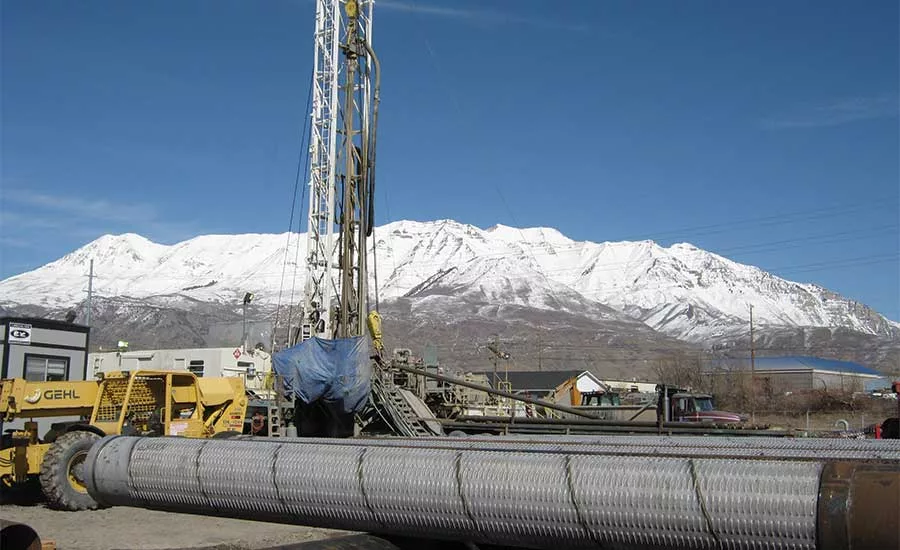Reverse Circulation: Getting Help from Air on Drilling Jobs

Reverse circulation is best for large-diameter bores or areas with a high risk of lost circulation.
Source: Central Utah Water Conservancy District
Between conventional mud drilling and straight air drilling, there is another method that is well adapted to many parts of the country: reverse circulation drilling. In this method, the fluid and cuttings flow up the drill pipe instead of down, as with conventional drilling. The two most common uses are for large holes — 20-inches and larger — and in severe lost circulation zones where normal circulation can’t be maintained.
For large holes, where lost circulation isn’t a problem and circulation can be maintained, a jet eductor (JED) system is used. This uses a pump to move high-pressure fluid through a jet system to pull a vacuum on the drill pipe. Mud and cuttings return through the drill pipe into the pit. Water is added to keep fluid flowing back into the hole. If the hole is drinking too much water, it is common to use a bentonite slurry to help build wall cake downhole. This system works best in holes with a high fluid level, usually less than 20 feet.
In areas with deep fluid level, a vacuum eductor can’t lift the fluid and cuttings, so an air assist system is used. With this system, an airline — usually plastic — is run inside the drill pipe and hooked to a suitable compressor. Air is forced down and lifts the fluid and the cuttings. This works fine in wells that have a deep static fluid level, and especially well in formations that make a lot of water. If the well is not making much water, fluid can be added from the top, down the outside of the drill string. If the well makes a lot of water, you will have to find a way to get rid of it, either by hauling it off or by flowing it to a ditch or pond. There are usually state-specific regulations that must be followed. For instance in Florida, the return water had to be fresh and have very low turbidity. This led to some interesting solutions to get the turbidity low enough to pass inspection.
When installing an airline, drillers need to have a good idea what the static level will be in the well and of the capabilities of the compressor. It is similar to air development, except the hydrostatic head of the fluid changes as the pipe must carry cuttings as well as fluid. In other words, the airline can’t be as deep for drilling as it might be for development, because the air must lift a heavier fluid. It doesn’t make much difference how deep the bit is. It is the depth of the airline that matters.
Most drillers nowadays use a PVC airline because it is cheap and easy to handle. Keep in mind that this airline is a sacrificial part. The cuttings will eventually cut it off and drop it to the bottom. Don’t worry though; it’ll stop at the bit, and you can recover it on your next trip. Just run another airline and continue drilling. It’s easy to tell when you have cut your airline because the flow will stop or slow way down and air pressure will fall.
Probably the most important gauge a driller can have for air-assisted reverse drilling is a good, accurate air gauge on your airline. Very slight changes in air pressure will tell you a lot about what the bit and the hole are doing. Keep in mind that, when drilling a large hole, you are going to be removing a lot of material. It is fairly easy for the bit to “outrun” the ability of air to clean the hole. This is where a good gauge comes in. If the hole is making plenty of water, note the air pressure before you start drilling and after the well stabilizes at whatever rate your assembly can produce. Then, keep a close eye on it. A decrease of only a few psi will warn you that you are plugging the bit. When this happens, pick up off bottom and vigorously shake the pipe. This will usually dislodge the plug and you can continue. If you can’t shake it loose, you will probably have to pull out of the hole to dislodge the plug. Embarrassing, and it doesn’t look good on the daily report.
One good thing about air-assisted reverse is that you are not losing any mud into your producing formation, and the well will probably need very little development, as it being developed as you drill. In fractured limestone or hard volcanic formations, it is common to just run the test pump as soon as you are done drilling.
There are a few other tricks to this type of drilling. Sometimes, they are very site specific. It can be a learn-as-you-go deal, but if I can help, just let me know.
For more Wayne Nash columns, visit www.thedriller.com/wayne.
Looking for a reprint of this article?
From high-res PDFs to custom plaques, order your copy today!

